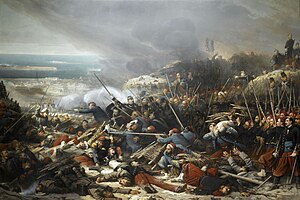
Back معركة مالاكوف Arabic Batalla de Malakoff Catalan Batalla de Malakoff Spanish Bataille de Malakoff French Battaglia di Malachov Italian Slag bij Malachov Dutch Batalha de Malakoff Portuguese Bătălia de la Malahov Romanian Malakof Muharebesi Turkish Trận Malakoff Vietnamese
| Battle of Malakoff | |||||||
|---|---|---|---|---|---|---|---|
| Part of the siege of Sevastopol and the Crimean War | |||||||
 The Battle of Malakoff by Adolphe Yvon | |||||||
| |||||||
| Belligerents | |||||||
|
|
| ||||||
| Commanders and leaders | |||||||
|
|
| ||||||
| Strength | |||||||
|
70,500[4] |
59,500[4] | ||||||
| Casualties and losses | |||||||
|
1st assault: 5,000[f] 7,546[21] to 10,000[22] |
1st assault: 1,500[h] 13,000[22] | ||||||



The Battle of Malakoff (French: Bataille de Malakoff, Russian: Бой на Малаховом кургане) or the Storming of the Malakhov Kurgan[23] (Russian: Штурм Малахова кургана) was a series of French attacks against Russian forces on the Malakoff redoubt. The first attack was unsuccessful, and occurred on 18 June 1855; subsequent capture of the redoubt was on 8 September 1855. The assaults were parts of the Crimean War and the siege of Sevastopol. The French army under General MacMahon successfully stormed the Malakoff redoubt on 8th, while a simultaneous British attack on the Redan to the south of the Malakoff was repulsed. In one of the war's defining moments, the French zouave Eugène Libaut raised the French flag on the top of the Russian redoubt. The battle of Malakoff resulted in the fall of Sevastopol on 9 September, bringing the 11-month siege to an end.
Cite error: There are <ref group=lower-alpha> tags or {{efn}} templates on this page, but the references will not show without a {{reflist|group=lower-alpha}} template or {{notelist}} template (see the help page).
- ^ Fletcher & Ishchenko 2004, p. 416.
- ^ a b c Guillemin 1981, p. 176.
- ^ Fletcher & Ishchenko 2004, pp. 501–504.
- ^ a b The Crimean War: A Clash of Empires by Ian Fletcher & Natalia Ishchenko
- ^ a b c d Fletcher & Ishchenko 2004, pp. 401–402.
- ^ a b Guillemin 1981, p. 174.
- ^ a b Totleben 1863, p. 352, vol. 2.
- ^ a b Gouttman 2006, p. 318.
- ^ a b Skorikov 1997, p. 243.
- ^ a b Fletcher & Ishchenko 2004, p. 452.
- ^ a b Fletcher & Ishchenko 2004, pp. 458–459.
- ^ a b Figes 2012, p. 388.
- ^ a b Guillemin 1981, p. 194.
- ^ a b Gouttman 2006, p. 348.
- ^ a b Gooch 1959, p. 223.
- ^ a b Gouttman 2006, p. 328.
- ^ a b Figes 2012, p. 371.
- ^ a b Fletcher & Ishchenko 2004, pp. 475, 493.
- ^ a b Guillemin 1981, p. 201.
- ^ a b Gouttman 2006, p. 360.
- ^ Clodfelter M. Warfare and armed conflicts : a statistical encyclopedia of casualty and other figures, 1494-2007. McFarland. 2008. P. 195
- ^ a b Tucker S. C. A Global Chronology of Conflict: From the Ancient World to the Modern Middle East: From the Ancient World to the Modern Middle East. ABC-CLIO. 2009. P. 1218
- ^ Velichko et al. 1915.
© MMXXIII Rich X Search. We shall prevail. All rights reserved. Rich X Search